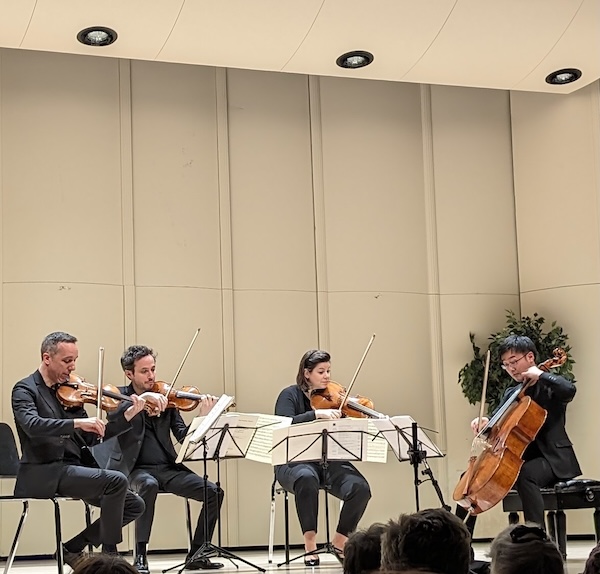Retooled Quatuor Ébène in first-class form at Shriver Hall

The Quatuor Ébène was last heard locally in 2014 at the Library of Congress. In the decade since that appearance, the group has switched out half of its former personnel. Their Baltimore debut, heard Sunday evening at Shriver Hall in Baltimore, offered the first chance to hear the new formation, with Marie Chilemme, violist since 2017, and cellist Yuya Okamoto, who joined just this year.
Okamoto, born in Japan but now based in Munich, is the first non-French member of this celebrated quartet. He replaces Raphaël Merlin, who left the group after twenty years to become music director of l’Orchestre de Chambre de Genève. The group’s current tour, which began in February, marks their maiden performances together.
The program, likely conceived before the personnel change, turned out to be an ideal way to present the new cellist and highlight the remarkable ease with which he has settled into the group.
Mozart composed his String Quartet No. 21, in 1789, the first of the so-called “Prussian” Quartets. It came in response to a commission from Friedrich Wilhelm II, the King of Prussia and an avid amateur cellist, whom the composer had met in Potsdam earlier that year.
In the first movement, the cello part has only rests initially, joining later on a prominent solo line. Okamoto handled his new role with aplomb, playing this and the many outstanding lead phrases given to the cello throughout the quartet with a rich, confident tone. All four musicians seemed to work together as if they had been an ensemble for much longer than a few weeks, marking the recapitulation of the first movement as one with a collective gentle ease.
The remarkable unity of the quartet continued in the slow movement, with Okamoto trading phrases with first violinist Pierre Columbet and violist Marie Chilemme. Columbet’s high range turned a little steely in the fast-paced Menuetto, but both violinists and violist handed off a triadic motif playfully, like passing a hot potato. The Finale, with its many contrapuntal sections revealing all four musicians in equal confidence, sealed the impression of a quartet once known primarily for its take on modern repertoire, extending its reach.
Alfred Schnittke’s String Quartet No. 3, composed in 1983, made clear the continuation of the group’s modern specialization. With exceptionally balanced sound, mostly senza vibrato, the musicians presented the three historical allusions made by Schnittke at the start of the first movement, all marked in the score: a tranquil cadence from a Stabat Mater by Lassus, the theme of Beethoven’s Grosse Fuge, and the name theme of Dmitri Shostakovich.
Dissonances did not always clash and irritate in this performance, often buffed of their edges with clarity of intonation. A contrapuntal section of close imitation, with each instrument closely layered over the next, sounded like a ghostly echo. Schnittke undercuts the joking rondo theme of the second movement, a repetitive tune in minor, with violent outbursts of unrelated material. A relentless crescendo on an obstinate rhythmic motif crowned the movement.
The absurdly weighty funeral march of the third movement again recalled Shostakovich. The Doppler-effect swells toward the end, crazy bursts of sound, revealed the dynamic range of the four musicians, with the new cellist again proving his mettle at the later end of the historical spectrum.
After intermission came Grieg’s String Quartet in G Minor, which proved a chance for the quartet to play at being the sonic equivalent of an entire orchestra. After a moody introduction to the first movement, with yearning melodic lines, the fast section offered impressive dynamic contrasts between the full-throated first theme and the furtive second theme. Throughout the movement, Marie Chilemme’s sensitive solo playing showed her to be no less a solid addition to the quartet than her more recently added colleague.
Both violinists excelled with bravura tone, with second violinist Gabriel Le Magadure matching Colombet step for step. In the coda of the first movement, Okamoto nailed the cello solo, again showing that the Ébène is embarking on what should be a very successful collaboration. He handled the opening of the second movement, a sentimental waltz, with similar assurance, as all four musicians created striking contrasts of texture from section to section.
The Intermezzo movement had a pleasing, driving character in its A section, matched by the more folksy B section, like a homey reel marked with trills. The four musicians negotiated the tricky hemiola shifts at the end of the piece with remarkable assurance. The Finale, taken at a breath-taking pace, provided a closing set of thrills and rounded out the picture of a quartet seemingly able to face all musical challenges.
Unexpected encores have always having been a special calling card for the Ébène, and the group did not disappoint. Offering something “a bit quieter than the Grieg,” as one of the players put it, the group played an arrangement of the first movement of Schumann’s Bunte Blätter. A brilliantly distilled few drops of cooling refreshment, the piece rounded out an extraordinary evening of music making.
The Quatuor Ébène’s U.S. tour continues with performances in Houston (April 9) Salt Lake City (April 10), Costa Mesa (April 11), La Jolla (April 12), Santa Fe (April 14) and Berkeley (April 16). quatuorebene.com
Cellist Johannes Moser and pianist Marc-André Hamelin perform music by Debussy, Franck, Nadia Boulanger, and Hamelin 5:30 p.m. April 21. Shriver Hall has also announced the details of its 2024-2025 season. shriverconcerts.org